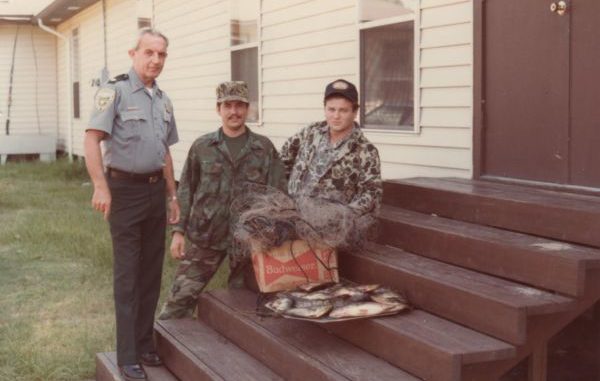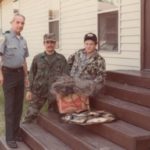
Going the extra mile to catch illegal netters
February can be a little slow, as far as hunting and fishing goes. Hunting seasons are ending. The fish aren’t spawning yet, and besides it’s still pretty cold for getting in a boat.
But in Central and North Louisiana, where a “speck” is a crappie and not a speckled trout, where it is a “white perch” and not a “sac-a-lait,” a little fishing is going on — and most of it is going on in the dark.
And it’s not exactly legal.
Nor does it involve rods, reels and hooks. What it does involve are nets, and whether they be gill nets or hoop nets it is all about catching nice, big crappie.
It is no secret that taking crappie illegally with nets has historically been very prevalent in Louisiana. The weapons of choice are 2-inch gill nets and 1-inch hoop nets.
For those of you who don’t know, the gill net is strung out over distances of 100 yards or more. It is suspended from the surface of the water to a depth of 3 or 4 feet. It catches fish by entanglement of the head or gills.
Gill nets with a square measure from knot to knot of 3 inches or more are legal in freshwater areas for taking commercial fish species. The 3-inch or greater square allows smaller fish and most game fish to escape.
But the 2-inch square is death on crappie.
The hoop net is a collapsible/extendable contraption made of metal or wooden hoops (usually 1 to 3 feet in diameter) with 1-inch or greater mesh netting stretched over the hoops. It has one or more funnel-shaped entrances allowing fish to swim in but not out, and it is stretched tight below the surface of the water in a likely location where fish will enter, seeking cover.
Like the roach hotel, they can check in but they can’t check out.
The hoop net is legal for use by properly licensed fishermen, but game fish — including crappie — must be released. Well, they are supposed to be.
To me, hoop nets are worse than gill nets because they are easily concealed, will catch fish indefinitely and can catch in cold weather for weeks until the fisherman decides it is safe to take his illicit harvest.
Cold temperatures are the reason game fish netting is so prevalent in late winter and early spring. The fish live longer in the nets, and that is a benefit to the illegal netters who set the nets and plan to return later for the catch.
If the game warden shows up snooping around, no worry, no hurry — just wait until he leaves.
Making an arrest is not easy, particularly where the hoop nets are used. They are the preferred gear in shallow-water lakes, creeks, bayous and rivers. As mentioned earlier, they are easy to hide and hard to find.
Working hoop netters is a lengthy process that begins with finding the nets. Where I worked, there was no need to wait for anyone to report crappie netting. We knew when it was going on and pretty much where.
Step one was finding the nets. We used net drags, a weight, usually a short length of steel rod with small hooks welded to one end and a loop for a line on the other. Tie a rope to it, toss it over the side of the boat, hold it a little off the bottom and creep along in a likely area where the fisherman would place the net.
When we were lucky enough to snare a net, it would be lifted to the surface for a look. If it contained an abundance of crappie, it was lowered and left as we found it.
Step two was where it got tricky.
The hoop net itself was legal gear. If the fisherman was legally licensed and released the crappie and other game fish when he raised the net, there was no violation. No law was broken unless it was evident he intended to keep the crappie; usually that meant when he started the engine and got underway with crappie still on board.
So was this one to put under surveillance, or did the net belong to a legal guy?
Step three was where it got hard — surveillance. If the decision was made to “lay on the net,” the officer had to find a good place to hide and watch, avoid detection, put in the long hours required and be able to catch the offender if and when he showed up.
Sitting in a cold boat, in cold water, in cold temperatures is just downright misery. The agency issued insulated jumpsuits, but I was not a fan. They were thick, clumsy and binding and if you fell in the water, even wearing a PFD, you were highly likely to drown.
The other problem was figuring out whether we were already busted. Word travels fast when game wardens hit the lake, and people willing to admit it always told us the outlaws knew we were around before we could even launch the boat.
Game wardens put in a lot of long, cold hours on netters. Sometimes successfully, most times not.
But it was not always so bad. Cotile, Kincaid and Rodemacher Lakes are man-made reservoirs in Rapides Parish. The deep, clear waters hold nice big crappie, and gill nets were much more effective than hoop nets. The lakes were popular crappie holes in the ’80s, and lots of people night fished on the lakes using rod and reel or auto-fishing reels commonly called yo-yos.
Some of the more-brazen illegal netters would slip right in among the legals, put out a few yo-yos for show, and then string out a little gill webbing for the real fishing.
Many of the night fishermen, legal or otherwise, would remain in their boats on the water, but some would go to shore and build a fire to keep warm, going out to check the yo-yos (or net) periodically.
My working partners — the late Ronald Hill and Eric Stokes — and I loved working these lakes. We would wear plain clothes and use a small, unmarked boat. We would bring the coffee pot and sandwiches, get on shore where we could see out over the water, build a fire and get comfortable. As far as anyone knew we were just another trio of fishing buddies out for some crappie.
Night fishing, legal or otherwise, requires the use of lights. So when the fishermen would go out to run lines or raise the gill net, we would put the binoculars on them and watch. It was pretty easy to see someone raise a gill net in the beam of a spotlight, and we enjoyed quite a bit of success with this ruse.
Crappie netters, deer spotlighters and people selling game or fish were and are the big three no-nos with most sportsmen. That always struck me as a little odd, since I consider any violation to be harmful. But catching netters had a lot of public support, and that was fine with me.
But our best and most-demonstrative supporter was an enthusiastic fisherman named Bob Jackson. And Bob just happened to be the Honorable Judicial District Court Judge Robert Jackson.
I’ll never forget one day in court when a man I had cited for taking crappie with gill net was brought before Judge Jackson for arraignment. At arraignment, the defendant enters his plea and if the plea is guilty he is usually sentenced right then.
The assistant district attorney read the charges and the defendant pleaded guilty.
Judge Jackson looked over at me and asked how many feet of net the offender was using and how many fish he had. I provided the information. The judge then handed down his sentence. The violator was ordered to pay several dollars for each foot of gill net. He was then given an additional hefty fine for each fish in his possession.
It was a substantial amount and, if that was not surprising enough, Judge Jackson preceded to dress down this guy with a chewing no one in the courtroom was likely to forget.
Every once in a while, justice prevails.




